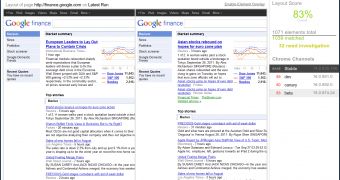Google has released a new open source tool designed to spot differences in how different versions of Google Chrome render a site. Dubbed QualityBots, it's aimed at developers and designers that want to make sure that a Chrome update won't screw up their sites.
Web standards have a very clear and specific purpose, to make sure that websites work and look the same in any browser, thus making it possible for web developers and designers to write one code that is guaranteed to work for all of their visitors.
Practice shows that this is rarely the case, different browsers implement standards differently, support only the features they want or support non-standard features.
In fact, there are even differences in how a site looks and feels between two different versions of the same browser, even if the changes are minimal, like in the case of Google Chrome.
Which is where the new tool from Google comes in. QualityBots runs a version of Chrome from all three channels, dev, beta and stable, along with Canary builds and checks for differences.
"It’s a comparison tool that examines web pages across different Chrome channels using pixel-based DOM analysis," Richard Bustamante, from the Google QualityBots team, explained.
"As new versions of Chrome are pushed, QualityBots serves as an early warning system for breakages. Additionally, it helps developers quickly and easily understand how their pages appear across Chrome channels," he said.
QualityBots uses Google App Engine for the front end, but the actual work is done on Amazon's EC2. The reason is simple, EC2 provides virtual machines to run Chrome in an environment as close to the native one as possible.
But this means that if you plan to use QualityBots, you need to set up an EC2 account. Google says that the decision to use EC2 rather than its own, pretty impressive computing infrastructure, has to do with responsibility, put simply, Google didn't want people running arbitrary sites on its machines.

 14 DAY TRIAL //
14 DAY TRIAL //